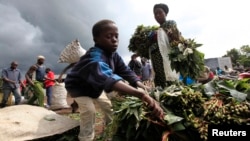Konzo is a crippling disease found mostly in Central and East Africa, and affecting mainly children. Now, an international team of researchers has found that it can affect the brains as well as the bodies of its young victims.
Konzo is essentially a result of cyanide poisoning. The cyanide comes from a staple food, a starchy tuber called bitter cassava, when it is not properly prepared. The name konzo comes from the Yaka language and means “tied legs.” And there is no cure.
“It’s irreversible neuromotor damage,” explains Michael J. Boivin, PhD, MPH, of Michigan State University. “It describes some of the abnormalities in walking and movement of the lower limbs, with the toes pointing in, distention of the heels and of the knees that tends to describe the initial onset of the disease.”
Since konzo is a neurological disease, Boivin wanted to see whether it was affecting brain function as well as control of the victim’s lower limbs. So he and his colleagues gave standardized tests to konzo-afflicted children in the Democratic Republic of Congo, as well as to children in the same communities who had no outward signs of the disease.
The scientists found that children with konzo scored lower on tests of memory and problem-solving than children without konzo.
“But even the non-konzo children were very at-risk in terms of certain aspects of memory and visual-spatial processing, when compared to children in similar living situations but from non-konzo affected communities,” Boivin said in a telephone interview.
So even children with no physical symptoms had measurable cognitive impairment.
There’s no cure for konzo, so the focus has to be on prevention. Traditional preparation of bitter cassava includes soaking the tuber in water for several days, followed by drying in the sun. “Those two processing practices," Boivin notes, "will usually break down enough of the cyanide derivatives to make it safe for consumption.”
But when communities face drought and other hardships, people take shortcuts with cassava preparation. So Boivin says the way to fight konzo is to stress traditional ways of preparing bitter cassava as well as to promote substituting other foods for at least some of the potentially toxic cassava.
The research by Michael Boivin, principal investigator Desire Tshala-Katumbay, and colleagues is published in the journal Pediatrics.
Konzo is essentially a result of cyanide poisoning. The cyanide comes from a staple food, a starchy tuber called bitter cassava, when it is not properly prepared. The name konzo comes from the Yaka language and means “tied legs.” And there is no cure.
“It’s irreversible neuromotor damage,” explains Michael J. Boivin, PhD, MPH, of Michigan State University. “It describes some of the abnormalities in walking and movement of the lower limbs, with the toes pointing in, distention of the heels and of the knees that tends to describe the initial onset of the disease.”
Since konzo is a neurological disease, Boivin wanted to see whether it was affecting brain function as well as control of the victim’s lower limbs. So he and his colleagues gave standardized tests to konzo-afflicted children in the Democratic Republic of Congo, as well as to children in the same communities who had no outward signs of the disease.
The scientists found that children with konzo scored lower on tests of memory and problem-solving than children without konzo.
“But even the non-konzo children were very at-risk in terms of certain aspects of memory and visual-spatial processing, when compared to children in similar living situations but from non-konzo affected communities,” Boivin said in a telephone interview.
So even children with no physical symptoms had measurable cognitive impairment.
There’s no cure for konzo, so the focus has to be on prevention. Traditional preparation of bitter cassava includes soaking the tuber in water for several days, followed by drying in the sun. “Those two processing practices," Boivin notes, "will usually break down enough of the cyanide derivatives to make it safe for consumption.”
But when communities face drought and other hardships, people take shortcuts with cassava preparation. So Boivin says the way to fight konzo is to stress traditional ways of preparing bitter cassava as well as to promote substituting other foods for at least some of the potentially toxic cassava.
The research by Michael Boivin, principal investigator Desire Tshala-Katumbay, and colleagues is published in the journal Pediatrics.






